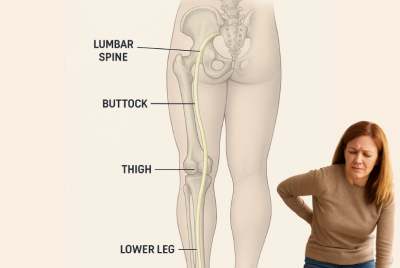Can Deep Breathing Help Sciatica
Discover how deep breathing techniques can alleviate sciatica pain. Learn more about how can deep breathing help sciatica relief starting now! Living with sciatica can be a challenging experience, as the pain and discomfort it brings can significantly disrupt daily life. As someone passionate about sciatica health and eager to provide helpful suggestions, I understand the frustration and the search for effective relief. In this article, I’ll delve into the potential benefits of deep breathing in managing sciatica and provide practical tips for incorporating deep breathing techniques into your routine.
Understanding Sciatica and Its Causes
Sciatica refers to pain that radiates along the path of the sciatic nerve, which branches from your lower back through your hips and buttocks and down each leg. It’s often caused by a herniated disk, bone spur on the spine, or narrowing of the spine (spinal stenosis), all of which put pressure on the sciatic nerve, resulting in pain, numbness, tingling, or weakness in the affected leg.
Role of Deep Breathing in Managing Sciatica
Deep breathing exercises can play a crucial role in managing sciatic pain by promoting relaxation and reducing stress levels. Stress and tension can exacerbate sciatic pain by causing muscles to contract, leading to increased pressure on the sciatic nerve. When we engage in deep breathing, we activate the body’s relaxation response, triggering the parasympathetic nervous system to counteract the stress response. This, in turn, promotes muscle relaxation, decreases tension, and alleviates pain associated with sciatica.
Breathing Technique to Reduce Sciatica Pain
Techniques for Deep Breathing
Diaphragmatic Breathing or Belly Breathing
Several deep breathing techniques can be beneficial for managing sciatic pain. One of the most commonly recommended techniques is diaphragmatic breathing, also known as belly breathing. It involves breathing deeply into the abdomen, allowing the diaphragm to fully expand and contract. This type of breathing encourages the body to relax, reducing muscle tension and promoting a sense of calm.
Alternate Nostril Breathing
Another effective deep breathing technique is alternate nostril breathing, a yogic practice that involves inhaling and exhaling through one nostril at a time while using the fingers to block the opposite nostril. This technique is believed to balance the flow of energy in the body, promoting relaxation and reducing stress.
Box Breathing or Square Breathing
Box breathing, also known as square breathing, is another simple yet powerful technique for deep relaxation. It involves inhaling for a count of four, holding the breath for a count of four, exhaling for a count of four, and holding the breath again for a count of four before repeating the cycle.
Incorporating Deep Breathing into Daily Routine
To reap the benefits of deep breathing, it’s essential to incorporate it into your daily routine. Set aside dedicated time each day for deep breathing exercises, preferably in a quiet, comfortable environment free from distractions. You can start with just a few minutes of deep breathing and gradually increase the duration as you become more comfortable with the practice.
It’s also helpful to experiment with different deep breathing techniques to find the ones that work best for you. Some people may prefer diaphragmatic breathing, while others may find alternate nostril breathing or box breathing more effective. The key is to choose a technique that feels comfortable and natural for you.
In addition to practicing deep breathing alone, you can integrate it with other relaxation techniques, such as meditation or progressive muscle relaxation, for enhanced pain relief. By combining deep breathing with other relaxation practices, you can create a comprehensive stress-reduction routine that promotes overall well-being.
Other Strategies for Managing Sciatic Pain
While deep breathing can be a valuable tool in managing sciatica, it’s essential to complement it with other strategies for comprehensive pain management. Regular exercise and stretching can help improve flexibility and strengthen the muscles surrounding the sciatic nerve. Focus on exercises that target the core muscles, such as Pilates or yoga, as well as gentle stretching exercises that help alleviate tension in the lower back and hips.
Good posture and ergonomics are also crucial for reducing pressure on the spine and minimizing sciatic pain. Avoid sitting or standing for long periods without breaks, and use ergonomic furniture and accessories to support your spine and maintain proper alignment.
In some cases, seeking professional treatments such as physical therapy or chiropractic care may be necessary to address underlying issues contributing to sciatic pain. A qualified healthcare provider can assess your condition and recommend personalized treatment options to help alleviate pain and improve mobility.
FAQs Related to Can Deep Breathing Help Sciatica
How often should I practice deep breathing for sciatica?
Aim to practice deep breathing exercises for at least 10-15 minutes each day to experience noticeable benefits in managing sciatic pain.
Can deep breathing alone cure sciatica?
While deep breathing can help alleviate symptoms of sciatica by promoting relaxation and reducing stress, it’s not a standalone cure. It should be combined with other strategies such as exercise, stretching, and professional treatments for comprehensive pain management.
Is it safe to do deep breathing exercises if I have other health conditions?
Deep breathing exercises are generally safe for most people, but it’s essential to consult with a healthcare professional, especially if you have underlying health conditions, such as respiratory disorders, that may be affected by deep breathing.
Can deep breathing help with acute sciatic pain?
Deep breathing can provide temporary relief from acute sciatic pain by promoting relaxation and reducing muscle tension. However, for severe or persistent pain, it’s essential to seek medical attention for proper diagnosis and treatment.
Are there any risks associated with deep breathing for sciatica?
Deep breathing exercises are low-risk and generally safe for most individuals. However, if you experience dizziness, shortness of breath, or any other adverse reactions during deep breathing exercises, stop immediately and consult with a healthcare professional.
Extra FAQs Related to Deep Breathing and Sciatica
Does sciatica hurt when you breathe?
Sciatica typically doesn’t hurt when you breathe directly. However, deep breathing can indirectly alleviate sciatic pain by promoting relaxation, reducing stress, and releasing tension in the muscles surrounding the sciatic nerve. This can provide relief from the discomfort associated with sciatica.
Why is deep breathing so powerful?
Deep breathing is powerful because it activates the body’s relaxation response, reducing stress, anxiety, and tension. It promotes oxygenation of tissues, enhances circulation, and releases endorphins, promoting feelings of well-being. Deep breathing techniques can improve mental clarity, physical relaxation, and overall health, offering numerous benefits for the mind and body.
Can deep breathing help nerve pain?
Yes, deep breathing can help alleviate nerve pain by promoting relaxation and reducing stress levels, which can, in turn, reduce muscle tension and alleviate pressure on nerves. Deep breathing activates the body’s relaxation response, providing relief from nerve pain.
Does deep breathing help lower back pain?
Yes, deep breathing can help lower back pain by promoting relaxation, reducing muscle tension, and improving circulation to the affected area. It triggers the body’s relaxation response, easing discomfort and supporting overall spinal health. Deep breathing techniques can complement other treatments for effective management of lower back pain.
How does breathing help with pain?
Deep breathing helps with pain by triggering the body’s relaxation response, reducing stress and tension. It promotes circulation, oxygenates tissues, and releases endorphins, natural pain-relieving hormones. Deep breathing also decreases muscle tension, alleviates pressure on nerves, reduces the perception of pain, offers relief, and enhances well-being.
Can Deep Breathing Help Sciatica – Conclusion
Incorporating deep breathing exercises into your daily routine can be a simple yet effective way to manage sciatic pain and improve overall well-being. By promoting relaxation and reducing stress levels, deep breathing can help alleviate tension in the muscles surrounding the sciatic nerve, providing much-needed relief from pain and discomfort. Combined with other strategies such as exercise, stretching, and professional treatments, deep breathing can contribute to a holistic approach to managing sciatica and enhancing quality of life.
Disclaimer
Please note that the information provided in this article is for informational purposes only and should not replace professional medical advice. If you’re experiencing sciatica pain or any health concerns, it’s advisable to consult a healthcare professional for proper diagnosis and treatment.






